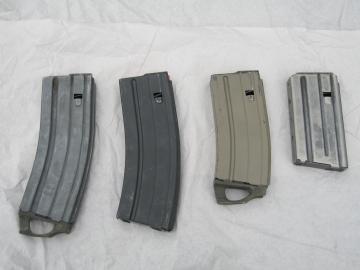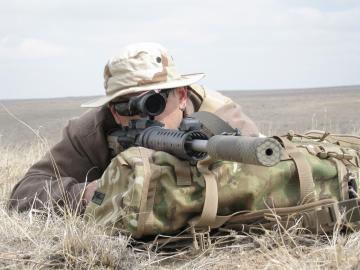
 Flanked by USGI M16 magazines (left and right), the 25 and 15-round PRI magazines (center) are
made of steel and have narrow ribs to accommodate the larger diameter of 6.8 SPC.
With the current emphasis on urban warfare and in particular shooting from
vehicles, short-barreled weapons are necessary. Because wrestling a 30-inch M4
is impractical inside a vehicle, short ten and 12-inch carbines have become
popular. Unfortunately, these short barrels simply cannot deliver the velocity
required for 5.56 fragmentation; they produce little more than 0.22-inch "ice
pick" holes. If converted to 6.8 SPC, these same ten to 12-inch carbines would
produce dramatically better terminal performance, especially at longer
distances. 6.8 SPC is a natural match for CQB where immediate stopping power is
needed in short and maneuverable weapons.
For police departments, 6.8 SPC provides substantially more "stopping power" per
good hit than 5.56, reducing the number of rounds required to end the fight.
This is an important consideration when each errant round is a legal liability.
It also offers much better intermediate barrier penetration than 5.56, which
allows an officer to shoot through glass, car doors, and other light cover. One
potential downside in a law-enforcement "entry" scenario is that 6.8 SPC will
penetrate more interior walls than 5.56, which might put building occupants in
adjacent rooms at increased risk.
With its sub-minute accuracy and superior
terminal performance even from short barrels, an officer can use the same
platform for entry, sniper, over-watch and patrol.

 The shooter uses his Kifaru Express pack in an improvised prone position, to
make hits on silhouette targets out to 600 yards sighting through the 3.5x
Trijicon ACOG.
My experience shooting 6.8 SPC has been with a custom upper built by Mid-South
Tactical Network (MSTN), configured with an 18-inch Douglas barrel, a mid-length
gas system and a GenIII PRI float tube. The muzzle device is a Vortex flash
hider, but any attachment with a .277-inch hole and the standard 5/8-24 threads
may be used, such as a sound suppressor. The primary optic is a Trijicon TA11
ACOG on a LaRue Tactical mount, but Troy back-up iron sights are installed "just
in case". With a trajectory similar to 75 or 77-grain .223, the same holds are
used for distant targets as a 16 or 18-inch .223 shooting heavy ammunition. The
18-inch 6.8 SPC is reliable and accurate. The recoil impulse is similar to 5.56
with a healthier push into the shoulder. With the upper swapped onto a Colt M4
lower, 6.8 SPC is controllable in full-auto, though it requires a good stance
and grip.
AR-15 uppers and complete rifles are available from many sources. Barrett was
first to announce a complete 6.8 SPC rifle, while PRI was offering complete
uppers. Model 1 Sales, DPMS, Ameetec, Olympic Arms and Stag Arms followed.
Custom uppers are available from low-volume, high-quality (and high price)
vendors like MSTN and Noveske Rifleworks. Remington has a version of its
bolt-action Light Tactical Rifle (LTR) in 6.8 SPC, Browning offers its A-Bolt
and Thompson/Center has 6.8 SPC barrels available for their G2 Contender and
Encore.
|